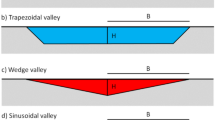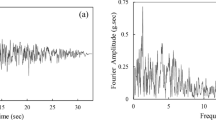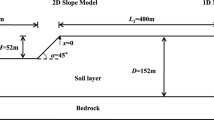Abstract
The seismic response of an alluvial valley is ruled by a complex combination of geometric and stratigraphic factors, which makes it hard to define a simplified amplification factor, to be adopted by the codes as it usually happens in the case of topographic and 1D stratigraphic amplification factors. This paper reports the results of an extensive parametric study aimed at analysing the influence of geometrical (e.g. shape ratio and inclination of the edges) and stratigraphic factors (e.g. impedance ratio) on the ground motion at surface of a trapezoidal valley. The soil behaviour has been assumed as linear visco-elastic. The results of the numerical analyses have been synthesised in terms of Valley Amplification Factor (VAF), defined as the ratio between the spectral ordinates obtained from 2D and 1D analysis, the latter carried out along a soil column corresponding to the centre of the valley. Based on the results of the parametric analysis, a simplified method was finally proposed, to calculate straightforward the VAF distribution along the valley.
Access provided by Autonomous University of Puebla. Download conference paper PDF
Similar content being viewed by others
Keywords
1 Introduction
The buried morphology of alluvial valleys strongly affects the seismic response at surface. Physically, the complex interference phenomena among the vertical propagation of body waves upcoming from the bedrock, the focusing of inclined refracted waves towards the valley centre and the surface waves generated from the valley edges lead to a significant change in amplitude and duration of the ground motion. The key parameters which mostly influence the seismic response of these morphologies are the shape ratio of the buried valley [1, 2], the impedance ratio [3], the slope of the edges [4], the frequency content of the reference input motion [5] and the non-linear properties of the alluvial soil filling the valley [6].
In recent years, numerous studies have been carried out to quantify the amplification of the seismic motion due to the presence of an alluvial valley and to define an appropriate Valley Amplification Factor, VAF [7]. However, an easily calculated VAF capable to adequately synthesise the effects of geometry, mechanical and non-linear soil properties on the seismic motion has not yet been found.
In order to quantify the 2D valley amplification as decoupled from the stratigraphic one, VAF can be defined as the ratio between peak or integral ground motion parameters computed by 2D and 1D analyses, as conventionally adopted in the evaluation of topographic amplification. Usually, in this approach the VAF is computed by 2D visco-elastic analyses assuming that it is not significantly affected by non-linear soil properties, that are deemed to be included in 1D stratigraphic amplification. Nevertheless, it has not yet been stated if it is possible to decouple geometric from stratigraphic effects and to quantify them separately [8].
This paper summarizes the results of an extended parametric study aimed at investigating the effects of the abovementioned parameters on the seismic response of shallow trapezoidal valleys (Fig. 1). Some charts are also proposed to be used to estimate the geometrical amplification quickly and easily along a valley profile and therefore can be considered as a starting point for the introduction of the basin effects in the building code.
2 Geotechnical Model
An extensive set of 2D numerical seismic response analyses of symmetrical trapezoidal valleys with fixed depth, H, and variable width, 2B (Fig. 1), was carried out to evaluate the influence of the geometrical and mechanical parameters on the ground motion at surface. Tables 1 and 2 summarize the geometrical and mechanical properties assigned in the parametric study. Being the shape ratio H/B lower than 0.25, all the analysed valleys can be classified as ‘shallow’ following the criterion suggested by Bard and Bouchon [3]. For each of the analysed models, a 1D site response analysis was also carried out along the vertical at the centre of the valley. The output of this latter analysis was then compared with that obtained from 2D models with the aim of isolating the geometrical effects from the stratigraphic amplification. A Ricker wavelet accelerogram with peak amplitude of 0.45 g and mean frequency, fm, varying between 0.05 and 11.60 Hz was used as input motion. It follows that the ratio between fm and the fundamental frequency of the 1D column, f0,1D, varies between 0.2 and 8, while that between the mean incident wavelength, λm, and the valley depth, H, varies between 20 and 0.5. Such a frequency range encompasses the occurrence of resonance phenomena at the fundamental and higher vibration modes of the reference vertical soil column.
The 2D numerical simulations were carried out with FLAC 8.0 [9] while the code STRATA [10] was adopted for 1D analyses, after verified the consistency between the predictions of both codes comparing the results of linear 1D analyses. For each different domain of analysis and value of VS of the alluvial soil, the maximum thickness of the elements of the mesh grid was assigned through the Kuhlemeyer and Lysmer [11] relationship, considering a maximum frequency of 20 Hz.
3 Results
1440 analyses were carried out considering 120 valley models subjected to 12 different input motions. The results of both 2D and 1D analyses were synthesized adopting the following amplification factor, A:
being \(S_{a,{\text{s}} } \left( {T,\frac{x}{B}} \right)\) and \(S_{a,r} (T)\) the spectral acceleration of the ground and input motion, respectively. To isolate the influence of 2D effects on the seismic response, a geometrical aggravation factor, AF, was then defined as the ratio between the 2D amplification at a generic location x/B and the 1D amplification at the valley centre:
At each point of the mesh along the surface and for each period, the average value of AF obtained from the analyses carried out adopting 12 input motions was calculated, thus obtaining an aggravation factor independent of the input frequency, defined as:
where m is the number of input signals considered, in this case 12. The factors thus obtained were further averaged within a period range between 0s and T0,1D (i.e. the resonance period of 1D column at the centre of the valley) to obtain a synthetic VAF, independent of period, and defined as follows:
The range of periods was selected based on the observation that no significant 2D effect was observed at periods exceeding T0,1D.
The so computed VAF along the surface depend on the shape ratio H/B and on the slope edge α of the valley, as well as on the impedance ratio I between the bedrock and the alluvial soil. In the following, VAF values greater than or equal to 1 were considered, thus neglecting any de-amplification effects that could be generated near to the edges. Figure 2a, b, c respectively show the influence of H/B, α and I on VAF. The analyses results evidenced that the centre of the valleys and the zones close to the edges are characterised by the highest VAF values.
At the centre of the valley, the peak of the VAF increases with H/B and I (Figs. 2a–c) due to the constructive interference between in-phase body and surface waves, that does not depend on the slope of the edges (see Fig. 2b) [7, 8, 12]. The maximum amplification at the edge is independent of H/B (Fig. 2a) and increases with α and I (Figs. 2b-c). Its position is strongly influenced by all the factors, moving toward the valley centre as H/B and I increase, and α decreases. More details on this can be found in Alleanza [12].
4 Proposed Charts
The computed VAF profiles show that the presence of a buried valley induces amplification of the ground motion mainly at the centre of the valley and next to the edge. For this reason, the VAF profiles along the valley have been further simplified defining a piecewise linear trend, identified by five relevant points (Fig. 3). The first is the value VAF(0) computed at the centre of the valley (x/B = 0, point 0 in Fig. 3), the second (point 1 in Fig. 3) identifies the lowest value of VAF computed between the peaks at the centre and near the edge of the valley, the third and the fourth (points 2, 3 in Fig. 3) are used to describe the maximum value of VAF at the side of the valley and the last one (point 4, x/B = 1) is set equal to 1, therefore neglecting any attenuation at the border of the valley.
All the computed VAF profiles were then processed to extract the five above-described points; the relevant values were represented as contour lines in six charts as a function of the impedance ratio and shape ratio. For given H/B and I the definition of each point of the piecewise linear trend is obtained enveloping the maxima VAF values, in this way implicitly including the dependency on the slope angle. Figure 4 shows the charts, which can be used to describe the piecewise trend of VAF expected for a valley characterised by a given H/B and I.
The amplification at the valley centre, VAF(0), increases with I and H/B, as shown by the chart in Fig. 4a. The magenta contour line in Fig. 4a, corresponding to VAF(0) = 1.05, represents the threshold below which almost no 2D amplification occurs at the centre of the valley. Particularly, H/B = 0.1 seems to be a threshold value of shape ratio, below which 2D effects are negligible at the valley centre. The shape ratio H/B = 0.1 seems to be a threshold value also for the determination of the abscissas x1/B (Fig. 4b), x2/B (Fig. 4d) and by x3/B (Fig. 4f) as well as for the minimum value of VAF along the valley, VAF(x1/B) (Fig. 4c): for H/B < 0.1 all those values are independent of I. Instead, Fig. 4e shows that the peak value at the edges, VAF(x2–3/B), is independent of H/B and increases with I. In other words, in the case of very shallow valley, i.e. H/B < 0.1, there is almost no 2D amplification along the valley surface unless near to the edges, where the amplification is a function of the impedance ratio. Note that even for H/B > 0.1 there are valleys for which VAF(0) is less than 1.05, but this is due to the low impedance ratio. In this case, the geometric and material damping is such that the Rayleigh waves transmitted to the valley do not have sufficient energy to significantly influence the motion at the centre of the valley. Instead, for values of H/B and I such that VAF(0) > 1.05, the 2D effects are not negligible along the whole valley profile. Therefore, shallow valleys can be further divided into two classes, ‘very shallow’ if H/B < 0.075–0.1 and ‘moderately shallow’ otherwise.
The above described charts can be a useful tool for a simplified and reasonably over-conservative estimation of 2D amplification along a trapezoidal valley or with a similar shape. As an example, Fig. 5a,b shows the comparisons between the VAF obtained using the charts and those computed by numerical analyses, for two valleys with same impedance ratio (I = 9.26) and H/B equal to 0.05 (‘very shallow’ valley A) and 0.25 (‘moderately shallow’ valley B), respectively. The black and red points reported in the charts of Fig. 4 represent the values adopted to draw the piecewise distributions of VAF, reported in Fig. 5, for Valley A and B, respectively. From the comparison it can be concluded that the proposed method provides an acceptable estimate of the amplification in the centre of the valley, while it is over-conservative at the edge of the valley.
5 Conclusion
This paper synthesises the results of extensive parametric 2D numerical analyses of the seismic response of homogeneous alluvial basins. A valley amplification factor was defined to quantify the 2D amplification along the valley: as expected, it was found to depend on the shape ratio and the edge slope of the valley, as well as on the bedrock/soil impedance ratio and on the frequency of the input motion normalised with respect to the one-dimensional resonance value. Based on these results, the paper proposes a simplified method for the evaluation of 2D amplification, adopting a set of charts allowing to compute an approximate VAF profile as a function of shape ratio and impedance ratio. The charts highlight that ‘shallow valleys’ can be further distinguished into two classes based on the value of the shape ratio. If H/B < 0.1 they can be considered as ‘very shallow’ basins characterised by slight 2D amplification at the centre of the valley, i.e. VAF(0) (Fig. 4a) lower than 1.05–1.10 until x1/B (Fig. 4b), gradually increasing approaching the edges. Therefore, the evaluation of site response by 1D numerical analyses can lead to a 5–10% underestimation of the spectral response along the zone between the centre of the valley and x1/B, while it can be completely misleading in the computation of the response at the edge. If H/B > 0.1, instead, the 2D effects are not negligible everywhere in the valley and thus they must be taken into account and computed with simplified or numerical methods.
References
Bard, P.Y., Bouchon, M.: The seismic response of sediment-filled valleys. Part 1. The case of incident SH waves. Bull. Seismol. Soc. Am. 70(4), 1263–1286 (1980)
Bard, P.Y., Bouchon, M.: The seismic response of sediment-filled valleys. Part 1. The case of incident P and SV waves. Bull. Seismol. Soc. Am. 70(5), 1921–1941 (1980)
Bard, P.Y., Bouchon, M.: The two-dimensional resonance of sediment-filled valleys. Bull. Seismol. Soc. Am. 75(2), 519–541 (1985)
Zhu, C., Thambiratnam, D.: Interaction of geometry and mechanical property of trapezoidal sedimentary basins with incident SH waves. Bull. Earthq. Eng. 110, 284–299 (2016)
Alleanza, G.A., Chiaradonna, A., d’Onofrio, A., Silvestri, F.: Parametric study on 2D effect on the seismic response of alluvial valleys. In: Silvestri, F., Moraci, N. (eds.) Earthquake Geotechnical Engineering for Protection and Development of Environment and Constructions: Proceedings of the 7th International Conference on Earthquake Geotechnical Engineering (ICEGE 2019), pp. 1082–1089. CRC Press, Rome (2019)
Gelagoti, F., Kourkoulis, R., Anastasopoulos, I., Tazoh, T., Gazetas, G.: Seismic wave propagation in a very soft alluvial valley: sensitivity to ground-motion details and soil nonlinearity, and generation of a parasitic vertical component. Bull. Seismol. Soc. Am. 100(6), 3035–3054 (2010)
Papadimitriou, A.G.: An engineering perspective on topography and valley effects on seismic ground motion. In: Silvestri, F., Moraci, N. (eds.) Earthquake Geotechnical Engineering for Protection and Development of Environment and Constructions: Proceedings of the 7th International Conference on Earthquake Geotechnical Engineering (ICEGE 2019), pp. 426–441. CRC Press, Rome (2019)
Alleanza, G.A., Allegretto, L.R., d’Onofrio, A., Silvestri, F.: Two-dimensional site effects on the seismic response of alluvial valleys: the case study of the Aterno river valley (Italy). In: Proceedings of the 20th International Conference on Soil Mechanics and Geotechnical Engineering, Sydney (2022). (Accepted paper)
Itasca Consulting Group, Inc.: FLAC—Fast Lagrangian Analysis of Continua, Ver. 8.0. Itasca, Minneapolis (2016)
Kottke, A.R., Rathje, E.M.: Technical manual for Strata. Report No.: 2008/10. Pacific Earthquake Engineering Research Center, University of California, Berkeley (2008)
Kuhlemeyer, R.L., Lysmer, J.: Finite element method accuracy for wave propagation problems. J. Soil Mech. Found. Div. 99(5), 421–427 (1973)
Alleanza, G.A.: Study of the seismic response of alluvial valleys. Doctoral dissertation in preparation. University of Napoli Federico II, Napoli, Italy (2022)
Acknowledgement
This work was carried out as part of WP16.1 “Seismic response analysis and liquefaction” in the framework of the research programme funded by Italian Civil Protection through the ReLUIS Consortium (DPC-ReLuis 2019–2021).
Author information
Authors and Affiliations
Corresponding author
Editor information
Editors and Affiliations
Rights and permissions
Copyright information
© 2022 The Author(s), under exclusive license to Springer Nature Switzerland AG
About this paper
Cite this paper
Alleanza, G.A., d’Onofrio, A., Silvestri, F. (2022). A Simplified Method to Evaluate the 2D Amplification of the Seismic Motion in Presence of Trapezoidal Alluvial Valley. In: Wang, L., Zhang, JM., Wang, R. (eds) Proceedings of the 4th International Conference on Performance Based Design in Earthquake Geotechnical Engineering (Beijing 2022). PBD-IV 2022. Geotechnical, Geological and Earthquake Engineering, vol 52. Springer, Cham. https://doi.org/10.1007/978-3-031-11898-2_41
Download citation
DOI: https://doi.org/10.1007/978-3-031-11898-2_41
Published:
Publisher Name: Springer, Cham
Print ISBN: 978-3-031-11897-5
Online ISBN: 978-3-031-11898-2
eBook Packages: Earth and Environmental ScienceEarth and Environmental Science (R0)









